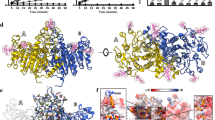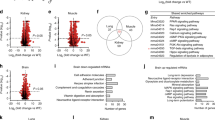Abstract
Vertebral and metaphyseal dysplasia, spasticity with cerebral calcifications, and strong predisposition to autoimmune diseases are the hallmarks of the genetic disorder spondyloenchondrodysplasia. We mapped a locus in five consanguineous families to chromosome 19p13 and identified mutations in ACP5, which encodes tartrate-resistant phosphatase (TRAP), in 14 affected individuals and showed that these mutations abolish enzyme function in the serum and cells of affected individuals. Phosphorylated osteopontin, a protein involved in bone reabsorption and in immune regulation, accumulates in serum, urine and cells cultured from TRAP-deficient individuals. Case-derived dendritic cells exhibit an altered cytokine profile and are more potent than matched control cells in stimulating allogeneic T cell proliferation in mixed lymphocyte reactions. These findings shed new light on the role of osteopontin and its regulation by TRAP in the pathogenesis of common autoimmune disorders.
This is a preview of subscription content, access via your institution
Access options
Subscribe to this journal
Receive 12 print issues and online access
$209.00 per year
only $17.42 per issue
Buy this article
- Purchase on Springer Link
- Instant access to full article PDF
Prices may be subject to local taxes which are calculated during checkout





Similar content being viewed by others
Accession codes
References
Walker, B.S., Lemon, H.M., Davison, M.M. & Schwartz, M.K. Acid phosphatases: a review. Am. J. Clin. Pathol. 24, 807–837 (1954).
Janckila, A.J. & Yam, L.T. Biology and clinical significance of tartrate-resistant acid phosphatases: new perspectives on an old enzyme. Calcif. Tissue Int. 85, 465–483 (2009).
Oddie, G.W. et al. Structure, function, and regulation of tartrate-resistant acid phosphatase. Bone 27, 575–584 (2000).
Hayman, A.R. Tartrate-resistant acid phosphatase (TRAP) and the osteoclast/immune cell dichotomy. Autoimmunity 41, 218–223 (2008).
Hayman, A.R. et al. Mice lacking tartrate-resistant acid phosphatase (Acp 5) have disrupted endochondral ossification and mild osteopetrosis. Development 122, 3151–3162 (1996).
Bune, A.J., Hayman, A.R., Evans, M.J. & Cox, T.M. Mice lacking tartrate-resistant acid phosphatase (Acp 5) have disordered macrophage inflammatory responses and reduced clearance of the pathogen, Staphylococcus aureus. Immunology 102, 103–113 (2001).
Esfandiari, E. et al. TRACP influences Th1 pathways by affecting dendritic cell function. J. Bone Miner. Res. 21, 1367–1376 (2006).
Schorr, S., Legum, C. & Ochshorn, M. Spondyloenchondrodysplasia. Enchondromatosis with severe platyspondyly in two brothers. Radiology 118, 133–139 (1976).
Menger, H., Kruse, K. & Spranger, J. Spondyloenchondrodysplasia. J. Med. Genet. 26, 93–99 (1989).
Frydman, M. et al. Possible heterogeneity in spondyloenchondrodysplasia: quadriparesis, basal ganglia calcifications, and chondrocyte inclusions. Am. J. Med. Genet. 36, 279–284 (1990).
Renella, R. et al. Spondyloenchondrodysplasia with spasticity, cerebral calcifications, and immune dysregulation: clinical and radiographic delineation of a pleiotropic disorder. Am. J. Med. Genet. A. 140, 541–550 (2006).
Schaerer, K. Ueber einen Fall von kindlichem Lupus erythematodes generalisatus mit eigenartigen Knochenveraenderungen. Helv. Paediatr. Acta 13, 40–68 (1958).
Nakanishi, M., Yoh, K., Uchida, K., Maruo, S. & Matsuoka, A. Improved method for measuring tartrate-resistant acid phosphatase activity in serum. Clin. Chem. 44, 221–225 (1998).
Halleen, J.M. et al. Tartrate-resistant acid phosphatase 5b: a novel serum marker of bone resorption. J. Bone Miner. Res. 15, 1337–1345 (2000).
Hayman, A.R., Macary, P., Lehner, P.J. & Cox, T.M. Tartrate-resistant acid phosphatase (Acp 5): identification in diverse human tissues and dendritic cells. J. Histochem. Cytochem. 49, 675–684 (2001).
Andersson, G. et al. TRACP as an osteopontin phosphatase. J. Bone Miner. Res. 18, 1912–1915 (2003).
Ek-Rylander, B., Flores, M., Wendel, M., Heinegard, D. & Andersson, G. Dephosphorylation of osteopontin and bone sialoprotein by osteoclastic tartrate-resistant acid phosphatase. Modulation of osteoclast adhesion in vitro. J. Biol. Chem. 269, 14853–14856 (1994).
Suter, A. et al. Overlapping functions of lysosomal acid phosphatase (LAP) and tartrate-resistant acid phosphatase (Acp5) revealed by doubly deficient mice. Development 128, 4899–4910 (2001).
Kazanecki, C.C., Uzwiak, D.J. & Denhardt, D.T. Control of osteopontin signaling and function by post-translational phosphorylation and protein folding. J. Cell. Biochem. 102, 912–924 (2007).
Senger, D.R., Perruzzi, C.A., Papadopoulos-Sergiou, A. & Van de Water, L. Adhesive properties of osteopontin: regulation by a naturally occurring thrombin-cleavage in close proximity to the GRGDS cell-binding domain. Mol. Biol. Cell 5, 565–574 (1994).
Yokosaki, Y. et al. The integrin alpha(9)beta(1) binds to a novel recognition sequence (SVVYGLR) in the thrombin-cleaved amino-terminal fragment of osteopontin. J. Biol. Chem. 274, 36328–36334 (1999).
Ashkar, S. et al. Eta-1 (osteopontin): an early component of type-1 (cell-mediated) immunity. Science 287, 860–864 (2000).
Kawamura, K. et al. Differentiation, maturation, and survival of dendritic cells by osteopontin regulation. Clin. Diagn. Lab. Immunol. 12, 206–212 (2005).
Burdo, T.H., Wood, M.R. & Fox, H.S. Osteopontin prevents monocyte recirculation and apoptosis. J. Leukoc. Biol. 81, 1504–1511 (2007).
Shinohara, M.L., Kim, J.H., Garcia, V.A. & Cantor, H. Engagement of the type I interferon receptor on dendritic cells inhibits T helper 17 cell development: role of intracellular osteopontin. Immunity 29, 68–78 (2008).
Murugaiyan, G., Mittal, A. & Weiner, H.L. Increased osteopontin expression in dendritic cells amplifies IL-17 production by CD4+ T cells in experimental autoimmune encephalomyelitis and in multiple sclerosis. J. Immunol. 181, 7480–7488 (2008).
Cantor, H. & Shinohara, M.L. Regulation of T-helper-cell lineage development by osteopontin: the inside story. Nat. Rev. Immunol. 9, 137–141 (2009).
Shinohara, M.L. et al. Osteopontin expression is essential for interferon-alpha production by plasmacytoid dendritic cells. Nat. Immunol. 7, 498–506 (2006).
Sun, P. et al. Acid phosphatase 5 is responsible for removing the mannose 6-phosphate recognition marker from lysosomal proteins. Proc. Natl. Acad. Sci. USA 105, 16590–16595 (2008).
Räisänen, S.R., Halleen, J., Parikka, V. & Vaananen, H.K. Tartrate-resistant acid phosphatase facilitates hydroxyl radical formation and colocalizes with phagocytosed Staphylococcus aureus in alveolar macrophages. Biochem. Biophys. Res. Commun. 288, 142–150 (2001).
Raisanen, S.R. et al. Macrophages overexpressing tartrate-resistant acid phosphatase show altered profile of free radical production and enhanced capacity of bacterial killing. Biochem. Biophys. Res. Commun. 331, 120–126 (2005).
Kaija, H. et al. Phosphatase and oxygen radical-generating activities of mammalian purple acid phosphatase are functionally independent. Biochem. Biophys. Res. Commun. 292, 128–132 (2002).
Weber, G.F. et al. Phosphorylation-dependent interaction of osteopontin with its receptors regulates macrophage migration and activation. J. Leukoc. Biol. 72, 752–761 (2002).
Steinman, L. A molecular trio in relapse and remission in multiple sclerosis. Nat. Rev. Immunol. 9, 440–447 (2009).
Chabas, D. et al. The influence of the proinflammatory cytokine, osteopontin, on autoimmune demyelinating disease. Science 294, 1731–1735 (2001).
Iizuka, J. et al. Introduction of an osteopontin gene confers the increase in B1 cell population and the production of anti-DNA autoantibodies. Lab. Invest. 78, 1523–1533 (1998).
Wong, C.K., Lit, L.C., Tam, L.S., Li, E.K. & Lam, C.W. Elevation of plasma osteopontin concentration is correlated with disease activity in patients with systemic lupus erythematosus. Rheumatology (Oxford) 44, 602–606 (2005).
Stromnes, I.M. & Goverman, J.M. Osteopontin-induced survival of T cells. Nat. Immunol. 8, 19–20 (2007).
Renkl, A.C. et al. Osteopontin functionally activates dendritic cells and induces their differentiation toward a Th1-polarizing phenotype. Blood 106, 946–955 (2005).
Hur, E.M. et al. Osteopontin-induced relapse and progression of autoimmune brain disease through enhanced survival of activated T cells. Nat. Immunol. 8, 74–83 (2007).
Vogt, M.H., Lopatinskaya, L., Smits, M., Polman, C.H. & Nagelkerken, L. Elevated osteopontin levels in active relapsing-remitting multiple sclerosis. Ann. Neurol. 53, 819–822 (2003).
D'Alfonso, S. et al. Two single-nucleotide polymorphisms in the 5′ and 3′ ends of the osteopontin gene contribute to susceptibility to systemic lupus erythematosus. Arthritis Rheum. 52, 539–547 (2005).
Abecasis, G.R., Cherny, S.S., Cookson, W.O. & Cardon, L.R. Merlin–rapid analysis of dense genetic maps using sparse gene flow trees. Nat. Genet. 30, 97–101 (2002).
Gudbjartsson, D.F., Thorvaldsson, T., Kong, A., Gunnarsson, G. & Ingolfsdottir, A. Allegro version 2. Nat. Genet. 37, 1015–1016 (2005).
Sträter, N. et al. Crystal structures of recombinant human purple Acid phosphatase with and without an inhibitory conformation of the repression loop. J. Mol. Biol. 351, 233–246 (2005).
Hellemans, J., Mortier, G., De Paepe, A., Speleman, F. & Vandesompele, J. qBase relative quantification framework and software for management and automated analysis of real-time quantitative PCR data. Genome Biol. 8, R19 (2007).
Hayman, A.R., Warburton, M.J., Pringle, J.A., Coles, B. & Chambers, T.J. Purification and characterization of a tartrate-resistant acid phosphatase from human osteoclastomas. Biochem. J. 261, 601–609 (1989).
Lausch, E. et al. Mutations in MMP9 and MMP13 determine the mode of inheritance and the clinical spectrum of metaphyseal anadysplasia. Am. J. Hum. Genet. 85, 168–178 (2009).
Rosenthal, A.K., Gohr, C.M., Uzuki, M. & Masuda, I. Osteopontin promotes pathologic mineralization in articular cartilage. Matrix Biol. 26, 96–105 (2007).
Banchereau, J. & Steinman, R.M. Dendritic cells and the control of immunity. Nature 392, 245–252 (1998).
Acknowledgements
We thank our cases and their families for participation in this study. We are also grateful to T. Velten and to the Lausch/Zabel lab for excellent technical assistance and to M. Osawa and H. Katumori, Tokyo, for clinical information. S. Ehl and his group at the Centre for Chronic Immunodeficiency in Freiburg were most helpful in discussing immunological aspects and experimental strategies. This work was made possible by continuous grant support from the Deutsche Forschungsgemeinschaft to E.L. and B.Z. (La 1381/1-3). B.Z. is also supported by the German Bundesministerium für Bildung und Forschung (SKELNET project), and A.S.-F. is supported by the Leenaards Foundation (Lausanne, Switzerland). The paper is dedicated to Céline and Sinai.
Author information
Authors and Affiliations
Contributions
E.L. and A.S.-F. conceived and initiated the project and E.L. designed functional studies. B.Z., A.S.-F. and E.L. secured financial support. Y.A., C.D.L., C.A.H., P.M., G.N., M.M., Y.H., S. Tenoutasse, A.K., R.F.M.R., S.L.U., R.R., L.B., J.S., B.Z., E.L. and A.S.-F. identified cases of SPENCD, provided clinical information and collected biologic materials. S.U., R.R., J.S., E.L. and A.S.-F. assessed the clinical and radiographic data for inclusion in the study. A.S.-F., E.L. and A.J. performed linkage and mutation analysis. E.L. performed biochemical analyses and statistical evaluation. E.L., M.B. and S. Trojandt performed the expression studies as well as the functional and immunological studies with dendritic cells. B.Z., S.U. and R.R. discussed the ongoing experiments with E.L. and A.S.-F. Finally, E.L., S.U., B.Z. and A.S.-F. wrote the manuscript.
Corresponding author
Ethics declarations
Competing interests
The authors declare no competing financial interests.
Supplementary information
Supplementary Text and Figures
Supplementary Note, Supplementary Table 1 and Supplementary Figures 1–3 (PDF 549 kb)
Rights and permissions
About this article
Cite this article
Lausch, E., Janecke, A., Bros, M. et al. Genetic deficiency of tartrate-resistant acid phosphatase associated with skeletal dysplasia, cerebral calcifications and autoimmunity. Nat Genet 43, 132–137 (2011). https://doi.org/10.1038/ng.749
Received:
Accepted:
Published:
Issue Date:
DOI: https://doi.org/10.1038/ng.749
This article is cited by
-
SPENCD Presenting with Evans Phenotype and Clinical Response to JAK1/2 Inhibitors—a Report of 2 Cases
Journal of Clinical Immunology (2023)
-
Spondyloenchondrodysplasia in five new patients: identification of three novel ACP5 variants with variable neurological presentations
Molecular Genetics and Genomics (2023)
-
Interferone als Schlüsselfaktoren für die Pathogenese, Diagnostik und Therapie
Monatsschrift Kinderheilkunde (2023)
-
The type I interferonopathies: 10 years on
Nature Reviews Immunology (2022)
-
Tartrate-resistant acid phosphatase 5 promotes pulmonary fibrosis by modulating β-catenin signaling
Nature Communications (2022)



